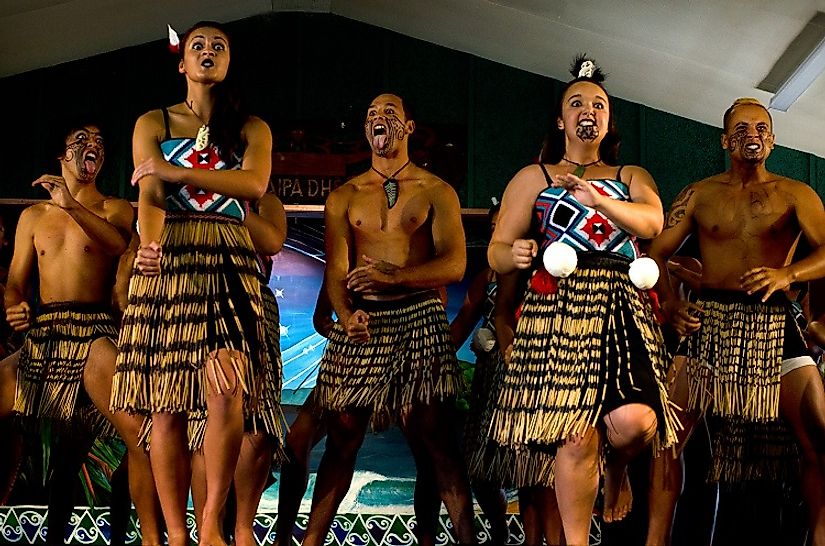The Maori - Cultures of the World

5. Description
In 1642, four members of the crew of Dutch navigator Abel Tasman were killed in a fierce encounter with the Maoris of New Zealand. This was perhaps the first introduction of the world to the presence of the Maoris. They are the indigenous inhabitants of New Zealand, and are believed to have arrived on the islands in canoes from the Polynesian Islands in the time period between the 9th and 13th Centuries AD. After Tasman’s encounter, several other European ships started visiting the island. From all of these, it is believed that the famous British explorer James Cook was the first to manage to establish friendly relations with the Maoris. With infiltration by Europeans, the Maori population started to decline, primarily due to the introduction of European diseases, to which they had no immunity. The Musket Wars, which took place between Maori tribes from 1807 to 1842, spelled further disaster within this community. Currently, about 15% of the population of New Zealand is comprised by members of the Maori people. Te Reo Maori, a language closely related to Tahitian and Hawaiian languages, is the traditional tongue of the Maoris.
4. Architecture
Originally, Maori architecture in New Zealand was influenced by the styles used back in their Polynesian homelands. Dwellings were temporary, and included small houses with low doors to keep the cold away. Wooden frames covered with reeds and leaves formed the walls of the houses, and fires were burnt inside to keep them warm. The architecture of the Maoris gradually developed with time and, during the 15th Century, they started building community houses called wharepuni. Such houses served as the resting places for many families, and were accompanied by storehouses called pātaka and large kitchens called kāuta. At a much later stage, during the Mid-19th Century, large meeting houses, referred to as whare whakairo, were built by the Maoris to discuss important issues. These houses often incorporated the use of European materials, and had carved decorations and porches to give them more impressive appearances. Over time, with infiltration of outsiders into Maori lands, the art of the Maoris began to decline, necessitating the establishment of arts and craft schools to conserve these cultural forms. Since the 1960s, Maori artists and architects started receiving more sufficient encouragement by the Government of New Zealand, which led to a significant revival of their ancient forms of art and architecture within the country.
3. Cuisine
Maori were excellent cultivators and were able to adapt the crops of yams, kumara, and taro brought with them from their original homelands to grow in the colder climate of New Zealand. The Polynesian rat (kiore) and dog (kurī) were introduced by the Maori with them in their new habitats, and served as important sources of meat. Seafood was an integral part of their diets, as were the birds which the Maoris hunted for food. Extensive use of pottery was not known in early Maori culture, and all they used for dining vessels were simple wooden or stone containers. The food prepared was often preserved by drying, and stored in the pātaka, Maori underground pits. The use of the hangi, an earthen pot for cooking, was a popular practice among the Maoris. Rewana bread, toroi, seaweed karengo, and dried and raw fish are some of the most notable of the traditional items of Maori cuisine.
2. Cultural Significance
Maori culture had, and continues to have, significant impacts on the lives of the people of New Zealand, both native and European. Their language, the Te Reo Maori, has been recognized as one of the three official languages of the country. Maori customs include two major aspects: manaakitanga and kaitiakitanga. The former preaches about the practice of kindness and hospitality towards a guest, and the latter inculcates reverence for nature and all of its beings. Both of these aspects are central to Maori culture and have been adopted by a larger section of New Zealanders, since these customs promise the future well-being of all. Another interesting feature of traditional Maori culture is the adornment of tattoos, called Tā moko, on the faces and bodies of men and women alike. These tattoos were used to define the classes in Maori culture, as well as being used for purposes of attracting members of the opposite sex. In line with their ancestors' physical prowess, many modern Maori list among the most exceptional New Zealand athletes in Rugby, Cricket, and other popular New Zealand sports alike.
1. Threats
Rapid urbanization and migration of Maori men and women to urban settlements threatens the practice of Maori customs and traditions. Indeed, Maori people living in modern, urban areas are usually unable to practice their traditional ways of life. Marriages to those outside their own culture has also led to the creation of an assimilated population, with the Maori culture gradually becoming diluted into that of the dominant New Zealand population and its European influences, which is more often than not given preference to in practice. However, since the travel and tourism industry in New Zealand draws a good deal of attention from outside visitors towards Maori culture, it is possible that this culture will continue to survive under the popular demand of revenue generating tourists in New Zealand. In fact, many people visit New Zealand just to learn more about, and experience for themselves, important elements of traditional Maori culture.











